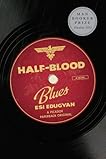My rating: 4 of 5 stars
Prisoner of Tehran by Marina Nemat was my second “Canada Reads 2012” book. When reviewing these books, I ask myself: Should this one win the Canada Reads contest?
Marina Nemat does not tell about her life in Canada; Prisoner of Tehran is a very personal account of her arrest at 16 by the Iranian Revolutionary Guard and subsequent escape a few years later.
The difference between this book and other political persecution stories is that Marina is saved by one of her captors. Ali falls in love with Marina after his first interrogation of her. How about that for love at first sight? Despite being kind to her, he threatens to harm her family and boyfriend if she does not accept his offer of marriage. Marriage will also allow her to leave prison.
Nemat’s narration is straightforward and easy to read, but it is also cool and makes me speculate about what is happening beneath that detached surface. The images of snow reflect the containment of grief and the reluctant appearance of angels.
There are some other striking images that show despair that cannot be controlled. For example, Marina’s friend, Sarah, while under arrest in Evin prison and just after hearing about the execution of her brother is compelled to write her memories all over her body and the walls of her cell. Only her back is left empty of words because she cannot reach back there.
As well, the book reveals the complexity of the Iranian Revolution. I love it when I learn something new. For example, I didn’t know about the lives of practising Christians in Iran. Also, the portrayal of Ali’s family is contradictory and human. They are so lovely. I wonder how Nemat feels about them, especially contrasted with her own emotionally removed family.
I think Prisoner of Tehran will help people who were born in Canada, understand and appreciate what others have gone through in order to get here. I often tweet quotes that resonate with me. The one from Prisoner of Tehran that was retweeted the most was: “I liked the name ‘Canada’—it sounded far away and very cold but peaceful.” The number of retweets shows that Canadians do want their country to be seen as a safe harbour. On the other hand, my experience with ESL students demonstrates that many people are intolerant and ignorant of what our new immigrants have gone and are going through.
Prisoner of Tehran is an important book because it tells just one of the stories that Canadian immigrants carry with them.
Perhaps, then, Prisoner of Tehran should be the winner of Canada Reads 2012.
View all my reviews
